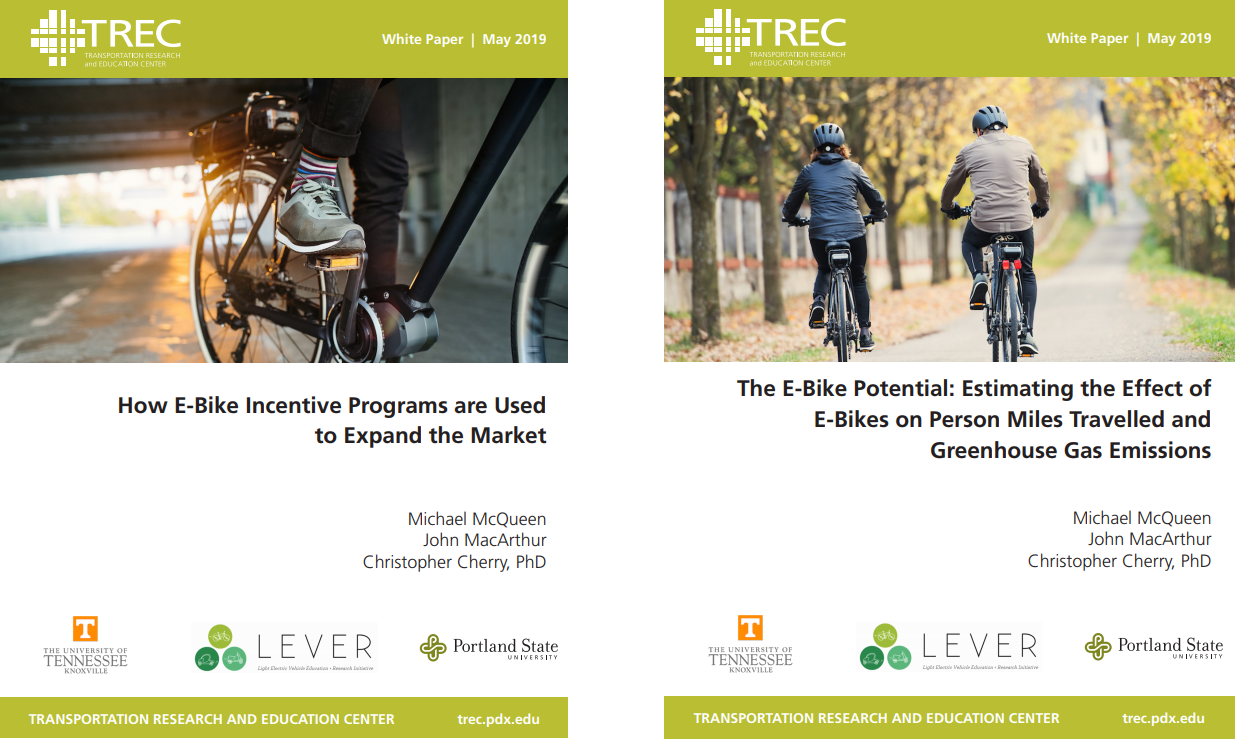The E-Bike Potential: How E-Bikes Can Improve Sustainable Transportation
John MacArthur and Michael McQueen, Portland State University; Christopher Cherry, University of Tennessee, Knoxville
- August 2020: Read the latest research paper with updated model & findings.
- Download the White Paper: Estimating the Effect of E-bikes On Person Miles Travelled and Greenhouse Gas Emissions (PDF)
- Download the White Paper: How E-Bike Incentive Programs are Used to Expand the Market (PDF)
- Upcoming Research Project: Novel approaches to model travel behavior and sustainability impacts of e-bike use
- Download the Project Brief (PDF)
There is an untapped potential for bicyclists in the people who self-identify as "Interested but Concerned," but hit barriers to jumping on a bike. Maybe they’ve got knee trouble, or they’re a parent toting children and groceries, or maybe they got pushed 15 miles out of the city center and don't want to arrive to work dripping with sweat.
Enter lane right: the e-bike.
Many U.S. cities have climate crisis goals for reducing automotive vehicles miles traveled (VMT) in order to reduce tailpipe emissions, so they make neighborhood greenways and car-free bridges hoping the choked arterials will be left behind. But that mass migration isn't happening. How do we reach the untapped potential for new bicyclists? Researchers behind the international LEVER Initiative, John MacArthur of Portland State University, PSU graduate research assistant Mike McQueen, and Christopher Cherry of the University of Tennessee, Knoxville found that wider adoption of e-bikes might be the answer.
They explore the potential effects of that mode shift, as well as how to incentivize widespread adoption of e-bikes in two new white papers:
Related to ongoing studies supported by the National Science Foundation, People For Bikes and the Bicycle Product Suppliers Association, the authors also used data from their earlier national survey of e-bike owners. These studies are leading up to their next installment that will collect real-time behavior data from participating e-bicyclists - learn more about joining this research cohort in Summer 2019.
THE POTENTIAL OF E-BIKES TO ADVANCE CLIMATE GOALS
Following the lead of a UC Davis global analysis in 2014, MacArthur and Cherry found that car PMT and total transportation emissions in Portland could be significantly reduced as e-bike mode share increases. Findings from the white paper are consistent with the global high shift cycling scenario. Given a 15% e-bike mode share in Portland, Oregon — the city's CO2 emissions would be reduced by over 900 metric tons per day. The researchers conclude that the strategy of increasing e-bike mode share within a given region can be used confidently as a tool to help meet that region’s carbon emission reduction goals. In Estimating the Effect of E-bikes On Person Miles Travelled and Greenhouse Gas Emissions, the researchers provide tools and recommendations for your city to determine the most accurate performance measures for mode shift goals.
So the "why" is clear, but this poses the question—how do we get people on e-bikes?
FOUR TYPES OF E-BIKE INCENTIVE PROGRAMS
A key finding from a previous study found that the high cost of e-bikes was a barrier to entry. The second white paper, How E-Bike Incentive Programs are Used to Expand the Market, explores techniques to develop and structure e-bike incentive programs to reduce that barrier and identified four main program structures:
Partial Purchase Subsidies The most common program, participants receive a purchase rebate funded by the program organizer.
Vendor-Funded Discounts Instead of a government funded flat rate rebate, some programs offer a discount that is unique to each specific model at the point of purchase and is funded exclusively by preferred retailers.
Employer-Sponsored Programs Employers can partner with an e-bike retailer to provide e-bikes for their employees to purchase or borrow.
Government Sponsored Loans Governments can incentivize residents to buy e-bikes by offering interest-free loans.
Naturally, there are also hybrid versions such as the UK's unique "Cycle to Work" program, which enjoys both government backing and employer participation.
After an international inventory of existing programs, the researchers found that the most popular were partial purchase subsidies. For example, Austin Energy in Austin, TX has offered incentives for e-ride devices since 2007, including e-bikes, scooters, mopeds and motorcycles. They offer a flat rate based on the price of the vehicle. The program has seen relatively high levels of participation, averaging about 100 rebates per year since the program began, with almost all of the awarded rebates having been for e-bikes.
Case studies for all program types, including international examples, can be found in the white paper.
DO YOUR HOMEWORK: CHOOSE THE RIGHT INCENTIVE PROGRAM FOR YOUR REGION
Incentive programs are not a one-size-fits-all, and local surveying is the ideal first step to determining which program will be most effective for your region. For example, a case study in Hanoi, Vietnam discovered that a change in sales tax had a stronger effect on vehicle choice than an equivalent change in purchase price. Further investigation would be necessary to measure the magnitude of an American aversion to sales tax to determine if this is a viable strategy for the U.S.
How much are people willing to pay? It depends. Surveys can reveal the "target price" of an e-bike for a given region. An incentive could be developed which lowers residents' cost to an optimized value determined by a localized study.
IF YOU BUILD THE PROGRAM, WILL THEY COME?
Finally, the team identified a set of best practices in implementing the e-bike incentive programs. In all program types, they found that experience-based education was an important tool to increase participation.
Researchers asked what makes a successful e-bike incentive program. One program leader said, "When people hop on e-bikes, that’s when everything changes." Another program leader referred to the experience of riding an e-bike as "joyful." It seems that just getting people on the e-bike in the first place is an effective hook.
One format of such an experience-based campaign is Local Motion, an e-bike lending library in Vermont. This program lets you borrow an e-bike for one week. It saw 106 e-bike loans in a 9-month period, with a 6 to 12-month post-loan purchase rate of 17%. One participant noted, "I definitely wouldn't have gotten the cargo e-bike if I hadn't borrowed Local Motion’s first. Now I ride to commute every day with my sons in tow."
Details on other experience-based campaigns can be found in the white paper.
THE NEXT PHASE: REAL-TIME E-BIKE BEHAVIOR DATA
The research team has already started on their next study in partnership with Bosch E-Bike Systems, which will measure real-world travel behavior of e-bicyclists and assess sustainability impacts. The team is developing a platform that is easily deployable, non-invasive, and leverages computing resources enabled by e-bike technology and smartphone sensor capability. This novel approach, never done before, will create a large and rich dataset to support the growth of e-bike use as a transportation option. The more participants, the better: Join the E-Bike Travel Behavior Study in 2019.
This research was funded by the National Science Foundation, with additional support from the Bicycle Product Suppliers Association, People For Bikes, and LEVER.
RELATED RESEARCH
To learn more about this and other TREC research, sign up for our monthly research newsletter.
Learn more about our work in e-bike research here.
Transportation Research and Education Center (TREC)
TREC at Portland State University is home to the National Institute for Transportation and Communities (NITC), the Initiative for Bicycle and Pedestrian Innovation (IBPI), and other transportation programs. TREC produces research and tools for transportation decision makers, develops K-12 curriculum to expand the diversity and capacity of the workforce, and engages students and young professionals through education.
The Light Electric Vehicle Education and Research (LEVER) Initiative is a consortium of Light Electric Vehicle (LEV) researchers and educators that currently includes faculty and staff from University of Tennessee, Portland State University, and Monash University. LEVER started in 2014 to bring together some of the leading researchers in the field to collectively answer some of the biggest questions related to these emerging vehicles. The mission of the LEVER is to bring a collective focus through interdisciplinary research directed at LEV adoption, system integration, societal impacts, and related policy. UTK's LEVER center will initiate the formation an international cooperative research center on LEVs, bridging academia, industry, government, and nongovernment organizations.




